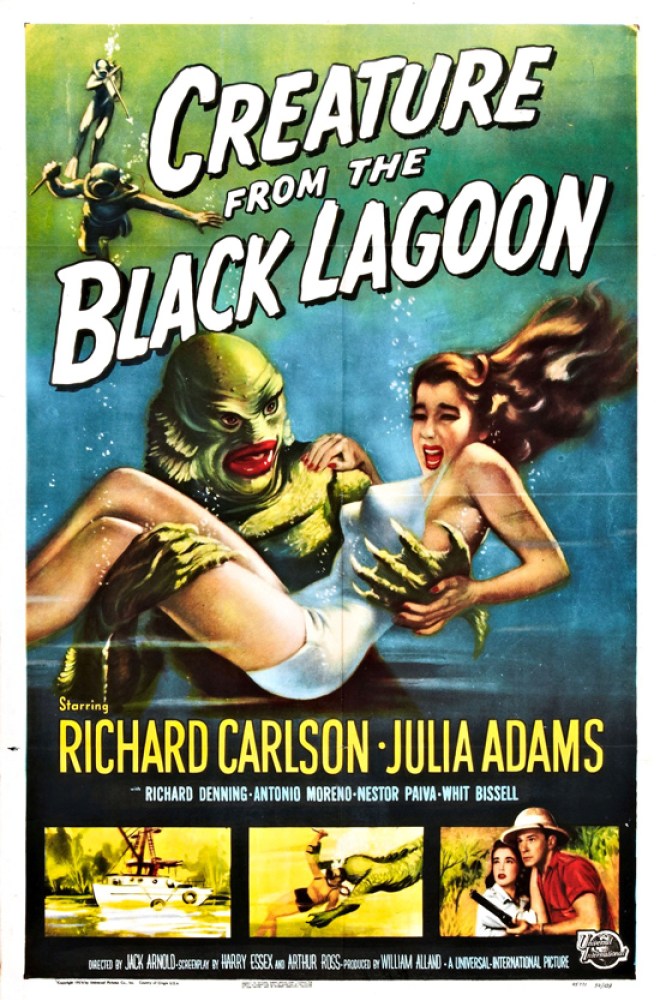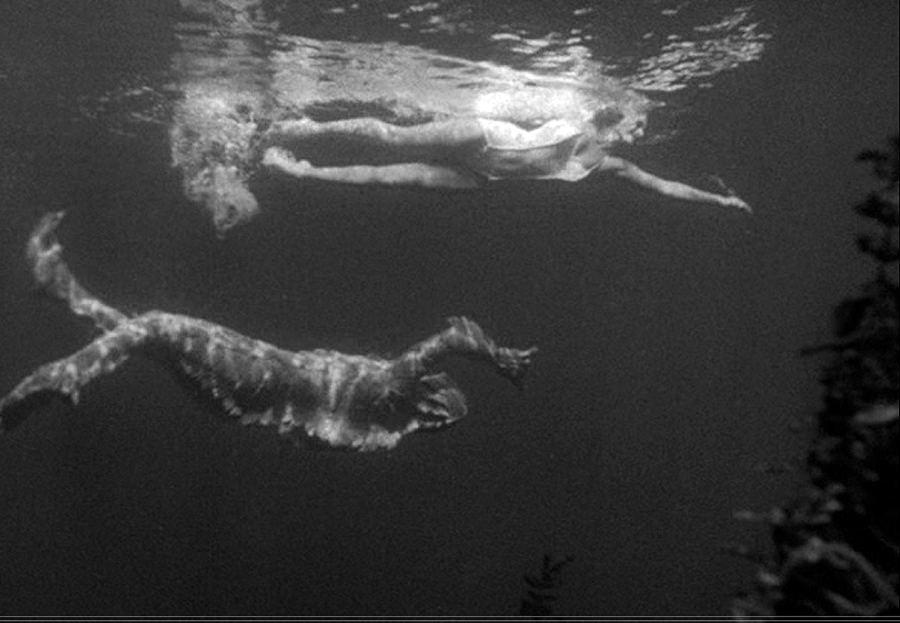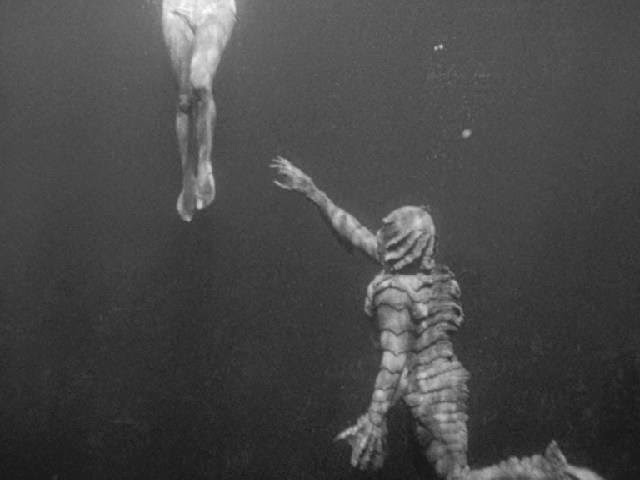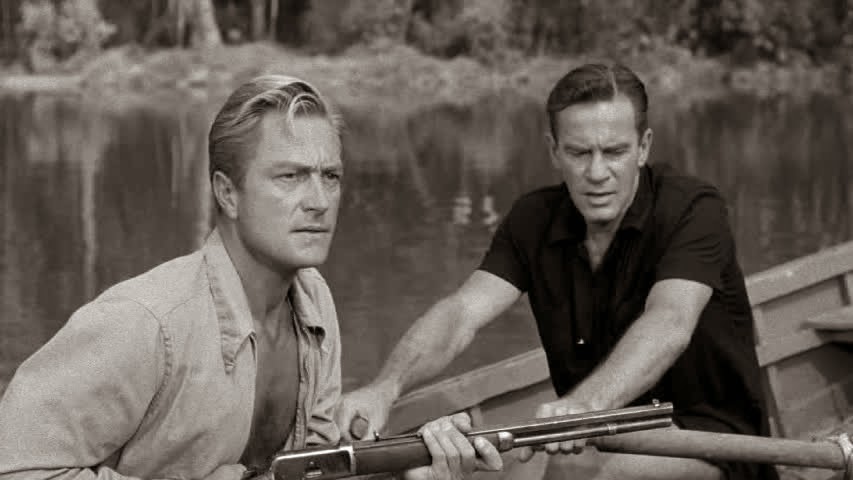1 hour 19 minutes: 7.0/10 from 20,081
It is a creature feature; it might even THE creature feature, but is it Sy Fy? Janne Wasse includes it on his Scifist because there is much pseudo-science in it about geomorphology, geology, geography, geostuff, topography, evolution, riverine systems, and the like. It is not the usual astronomy and space flight but it is science but there is not a mad scientist in sight.

The title passed into the vernacular two generations ago, understood by people who have never seen the movie and do not want to do so, and it spawned two sequels in an era when such follow-ups were rarer than is today a good film from Big Hollywood. More than 20,000 ratings puts it in the inner circle for such films on the IMDb. The two sequels were ‘Revenge of the Creature’ (1955) and ‘The Creature Walks among Us’ (1956) to be watched only for those who pursue the complete set, say the experts. Note that the sequels each had a distinctive title without a number on the evident assumption that audiences could figure it out. Not so today when numbers guide the prepubescent ticket buyer: Rocky 19, CGI Crap 13.
Here is the set-up. A strange fossilised skeleton is found in the upper reaches of the Amazon River. So strange is it that the Americans on sabbatical leave nearby become interested. These Americans are Richards Carlson and Denning and Julie Adams. Denning is the dean of a research institute, and he is totally preoccupied with funding, whereas Carlson is a rock-chopper, and Julie is the theorist whose work is praised more than once as vital, though we neither see nor hear any of it. To gold plate the Sy Fy credentials they take Whit Bissell, ever a fifth wheel in such capers.
Antonio is the local man who hires the boat and crew. Nestor is the captain and he is ready when the chips fall. Equipped they return to the site of the discovery to find two of Antonio’s men slashed to death, as though a crazed Canberra budget-cutter had got them. Oh, oh.
Well it is a jungle and such things, if distressing, are to be expected so they continue and set a guard. Much sweating in the Jeff Bezos sun follows with no result. Then after seminar gobbledegook, they decide to go further up river into….the Black Lagoon. Nestor. having peeked at the script, is not so sure this is a good idea but the money wins the argument.
With scuba gear there is much arresting underwater photography. However, the highpoint, which every viewer remembers, is the parallel water ballet between the lissom Julie Adams on the surface with a backstroke and….the Creature in depths below mimicking her turns, evolutions, and strokes. These are hormones falling in love with a vision come to his dark, remote world.

We know, by the way, that he slashed the peons earlier but we do not know why, and we never find out.
As Julie disports to wash off the hot day’s toil, she treads water upright to call to a Richard, and the Creature reaches for her foot.

It is delicate, almost shy approach. It tickles her toes and with a start, off she goes.
Julie and Carlson are a couple, very much so, but it is explicit from the near the beginning that they are not married. That was a risqué thing to say in a 1954 movie but there it is. They spend much time…together, when Denning thinks they should be earning his crust. There are words, low key but serious, about KMIs, Key Money Indicators.
Then a guard gets slashed and footprints are found from the Lagoon to the camp. The footprints are of a gigantic….creature!
Denning wants to capture it, seeing headlines and patrons throwing money at the institute. Carlson wants to take pictures of it (with largest iPhone ever seen) and come back with specialists to study this merman, a link to our primordial past, as heralded in the opening voiceover. (Not on the Fundamentalist list of top movies this one since it has much to say about evolution from the seas.) Julie wants to communicate with it but how…? An SMS? Antonio wants to get back for soccer game because Pelé is playing. Nestor wants to get paid. Whit Bissell patiently waits for a cue as supporting actors must.
Then, suddenly, it does not matter what they want. The Creature kills another peon, then after hiring a beaver as a consultant, damns the entrance to the Lagoon. They will have to fight their way out. They do. Denning is fish food, after saving Carlson, who saves Adams from a fate worse than a GOP majority.
The fraternity brothers counted: three missiles from the underwater spearguns stick in the Creature, he was shot three more times by a rifle from a distance, scorched with flaming kerosene, and blasted innumerable times up close by pistols, and still he went on. With skin this thick, he should be the dean.
For its time and setting, it is notable than all the peons had names, and the one who is wounded remains with the crew in the care of Julie, who as a theoretician can give him sips of water which no one else could do. When some of them are killed there is stunned silence and grief on the part of the principals that such nice and helpful chaps got wasted. By contrast in ‘The Snow Creature’ (1954), reviewed elsewhere on this blog, none of Japanese-speaking Nepalese peons have names and their deaths are merely inconvenient, not an occasion for regret and remorse.
Although she is assigned the screaming duties, Julie does pitch in during one crisis with more vigour than 1950s damsels were usually allowed. She had a subsequent long and distinguished acting career, but she is only ever remembered for this role, as she ruefully acknowledged in later life.
Though the discussions are abbreviated, it is also noteworthy that the Creature here is accorded some respect, again unlike ‘The Snow Creature’ (1954) which is treated as a big, huge, lab rat. Divided though they are in intentions, at the outset neither Richard means it any harm, but both want to prove its existence, one for further study and the other to reap publicity that will fund more B movies. Alternatives to bam-bam are aired and debated. Not so in most creature features of the era, where bam-bam is the first and last option as per the Snow Creature.
The Richards are B Sy Fy aristocrats, each with an impressive pedigree.
 Spot the Richards.
Spot the Richards.
Carlson is so ordinary that he is everyman, slightly withdrawn, thoughtful, and not an action man, but when action is required, well someone has to suck it up and get it done, and he does.
Denning’s character has a little edge here, which differs from his usual Mr Libra roles. The two of them spend most of their time in their underwear, ah, swimsuits, and it is evident to those with a sympathetic eye that there is gut-sucking going on.
Denning had been on the way up in A films before World War II, but when he returned from three years in the Army he had been surpassed by newer up-and-comers. He could not get any work.
With his GI loan, he and his wife bought a van in which to live and caught and sold lobsters off Long Beach to make a living, while he went to one audition after another, landing a few very small roles. Enough to give him hope of more to come but not enough to eat. One cheque a year is not enough. Evelyn Ankers, a scream queen from B movies, his wife, more or less gave up and concentrated on the lobsters.
By 1948 he had proven himself again: photogenic, compliant, always prepared, responsive to direction, affable, stable, reliable, and helpful if an another hand was needed on the set to do something. He went where the work was for him, to B pictures and made his career there.
The Hollywood Star System of the era had many laws and one the chasm between A and B pictures. The B pictures were made by B picture units and players. A young B picture director, writer, or actor, might rise to A-land and an A actor could slide into B never to return, but there was no free movement back and forth between the two worlds. All tickets were one-way. There was a similar wall between the A-land and television, whereas there was no such block for the B world, which is why as television grew it was populated with those from the B picture world in front of and behind the camera.
As Denning got back into the casting calls, Ankers gave up the lobsters to grace the silver screen once again.
The director was Jack Arnold. His name in the credits is almost always a guarantee of a brisk pace, artistic set-ups, quality camera work, good special effects, and care in establishing the context so that the action makes sense.
None of the actors ever saw the Black Lagoon that viewers see. They did their work in California getting wet in a water tank outside the studio. The Lagoon footage, including the ballet with the Creature and Julie’s body double was shot in Florida.
One critic at the time called it King Kong underwater. The Creature is the last of his kind and he discovers an impossible love that drives him to destroy those who get in his way, and finally to his own destruction. Well, something like that.
It was made in 3-D when that was the fad du jour. Creature features were made in 3-D for a few years, but it died because (1) it was expensive to shoot, about twice ordinary cost, (2) it was then expensive and difficult to project, and (3) only a few effects worked in 3-D.
Reasons (1) and (3) might not have been decisive, but (2) was. To project a 3-D movie in the Rivoli on Second Street in 1954 required two projectors (not one) and Dale McCulloch had to synchronise them to the single individual frame. One frame out of sync and the film became a blur to the audience, four of five out of step was an LSD trip. Moreover the film reels were so large even a modest feature like this had to have an intermission so that the second reels could be loaded and synchronised. The big studio sent technicians around the country to train projectionists, like Dale at the Rivoli, on projecting because it seemed that was the wave the future. Then it waved goodbye.
Skip to content
